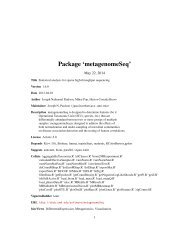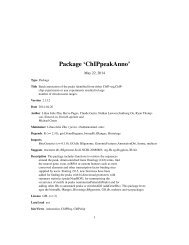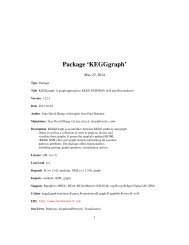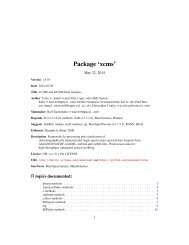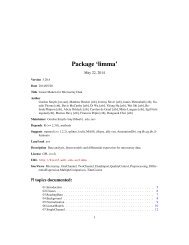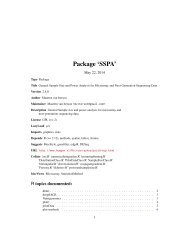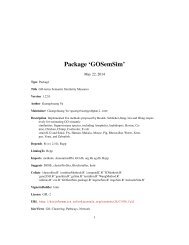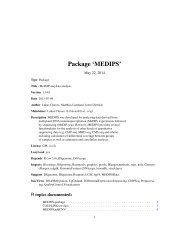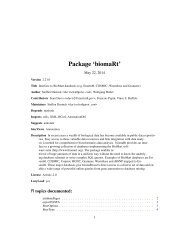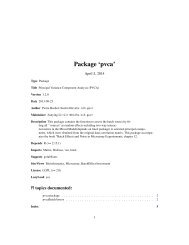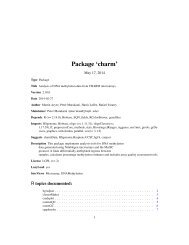Package 'pathview' - Bioconductor
Package 'pathview' - Bioconductor
Package 'pathview' - Bioconductor
You also want an ePaper? Increase the reach of your titles
YUMPU automatically turns print PDFs into web optimized ePapers that Google loves.
12 mol.summol.sumMapping and summation of molecular data onto standard IDsDescriptionUsageMolecular data like gene or metabolite data are frequently annotated by various types of IDs. Thisfunction maps and summarize molecular data onto standard gene or compound IDs. It would bestraightforward to integrate, analyze or visualize the "standardized" data with pathways or functionalcategories.mol.sum(mol.data, id.map, gene.annotpkg = "org.Hs.eg.db", sum.method =c("sum", "mean", "median", "max", "max.abs", "random")[1])Argumentsmol.dataid.mapgene.annotpkgsum.methodEither vector (single sample) or a matrix-like data (multiple sample). Vectorshould be numeric with molecule IDs as names or it may also be character ofmolecule IDs. Character vector is treated as discrete or count data. Matrixlikedata structure has molecules as rows and samples as columns. Row namesshould be molecule IDs. Default mol.data=NULL. This argument is equivalentto gene.data or cpd.data in the pathview function. Check pahtview function formore information.a two-column character matrix, giving the mapping between molecular IDs usedin mol.data and taget/standard molecular IDs. Then mol.data are gene data,id.map may also be a character specifying the type of IDs used in mol.data.The two-column mapping matrix will be generated automatically.character, name of the gene annotation package. This package should be oneof the standard annotation packages from <strong>Bioconductor</strong>, such as "org.Hs.eg.db"(default). Check data(bods); bods for a full list of standard annotation packages.You may also use your custom annotation package built with AnnotationDbi,the <strong>Bioconductor</strong> Annotation Database Interface. Only effective whenmol.data are gene.data and id.map gives the ID type being used.character, the method name to calculate node summary given that multiple genesor compounds are mapped to it. Poential options include "sum","mean", "median","max", "max.abs" and "random". Default sum.method="sum".DetailsThis function is called in pathview main function when gene.idtype or cpd.idtype is not the standardtype, so that the molecular data can be mapped and summarized onto standard IDs. This is neededfor further mapping to KEGG pathways. The same standard ID mapping is needed when carry outpathway or functional analysis on molecular data, which are labeled by non-standard (or alien) IDsor probe names, like in most of the microarray or metabolomics datasets. In other words, functionmol.sum can be useful in all these situations.



